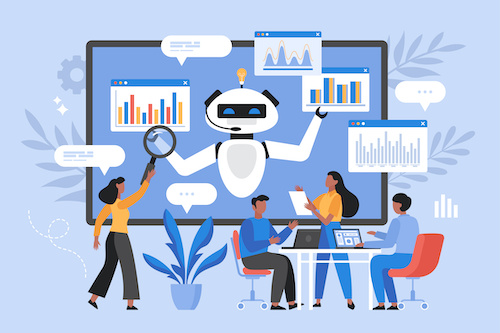Key points:
- Teachers are embracing AI and other emerging technologies to help elevate lesson plans and make challenging lessons more engaging
- AI can also help teachers alleviate the burden of tedious tasks and make learning more inclusive
- See related article: How to redefine learning in the digital age
- Everything You Need To Know About AI In Education
In the world of education, where innovation and creativity are especially vital, technologies with AI-generated content are reshaping teaching and how students learn in surprising ways.
There has been no shortage of news coverage on AI in education. However, much of that coverage has centered on the student experience. As a former teacher who now interacts with edtech companies on a daily basis, I think we miss a hugely important part of this conversation if we don’t also focus on how this technology could positively impact the teaching profession.
Here are just a few exciting ways that educators can be using AI to inspire creativity and drastically improve their impact on students:
1. Lift the burden of tedious tasks: On average, teachers work more than 50 hours per week but spend less than half of that time actually teaching students. By allowing teachers to automate potentially time-consuming tasks, these technologies give them more space to focus on student learning and differentiation. Kristina Holzweiss, who is in her 28th year as an educator in New York, said she has used ChatGPT to write course descriptions and college recommendations. The ability for teachers to have AI generate an initial lesson plan or class activity allows them to shift their valuable time towards refining content using their expertise, differentiating for all learners, and tailoring lessons to fit the needs and passions of their students. AI becomes a collaborative partner, not an adversary, freeing the educator to bring engaging learning experiences to life much more easily.
2. Enable greater differentiation and more inclusive classrooms: Teachers are already using AI-powered tools to create more inclusive learning experiences for all students. Erika Sandstrom, who currently works with students in grades 4-8 in Massachusetts, created a custom, animated template–something she calls “Breathing Bubbles”–that helps her students with mindfulness and breathing exercises. These animated templates used a text-to-image AI-powered feature to allow each student to personalize the breathing bubble they’ve conjured from their imagination. A student can dream up a memory, place, or activity that represents joy or peace and create a unique breathing bubble customized to them. This ability to personalize each exercise improved student engagement. Teachers can also leverage AI-powered platforms to more quickly adjust the difficulty of classwork based on a student’s reading abilities or level of understanding, allowing learners to progress at their own pace. Teachers can even leverage AI-generated content before a lesson, to proactively identify areas where students could struggle with a new concept and generate ideas to help them overcome hurdles. In other words, this technology has the potential to level the playing field for students and create classroom environments that make all learners feel supported.
3. Unlock creativity with new ideas: Oftentimes, the most difficult part of any classroom project is getting started. AI can help both teachers and students overcome even the nastiest case of writer’s block by analyzing enormous amounts of data and making personalized recommendations. Dr. Michael Vorasuang, director of the Office of Online Education at Thailand’s Sripatum University, said: “Leveraging AI as a collaborative partner helps me add new, creative ideas to educational projects. I enjoy using generative AI to draft engaging class discussion questions and even synthesize education research. Ultimately, this helps engage and inspire my students.”
4. Prepare students for a future with AI: As AI becomes more commonplace–and sophisticated–it is crucial to emphasize the importance of information literacy and responsible use. It can be extremely challenging to spot the difference between fact and fiction–to identify biases and hallucinations that could inevitably come with AI-generated content. We want every learner to unlock their creativity, but educators must also empower students to become more discerning consumers and creators of digital content, teaching them to think critically and confirm information from multiple sources. Teachers will benefit greatly from high-quality professional development opportunities on how to effectively and responsibly incorporate AI into their educational ecosystems. It almost goes without saying that school districts and policymakers will need to both collaborate with and seek input from educators to develop effective guidelines around student use.
AI-powered platforms can help teachers more easily cultivate an environment that allows students to collaborate, get creative, think critically, and communicate visually. And, in an age where teachers are being asked to shoulder an increasingly heavy load, AI-generated content can save time, unlock creativity, personalize learning, inspire joy, and ultimately make the profession more sustainable.
Although the implementation of these technologies might initially seem like extra work to some and flat-out scary to others, I strongly believe they have the power to create a more inclusive world by expanding the way students learn–and just as importantly, the way teachers engage and support them.
Related:
Debunking common myths about AI in education
4 AI-powered language tools I use in my classroom
- 4 ways to encourage play in education - April 25, 2024
- CoSN IT Leader Spotlight: Lisa Higgins - April 25, 2024
- It’s time to pay student teachers - April 25, 2024

